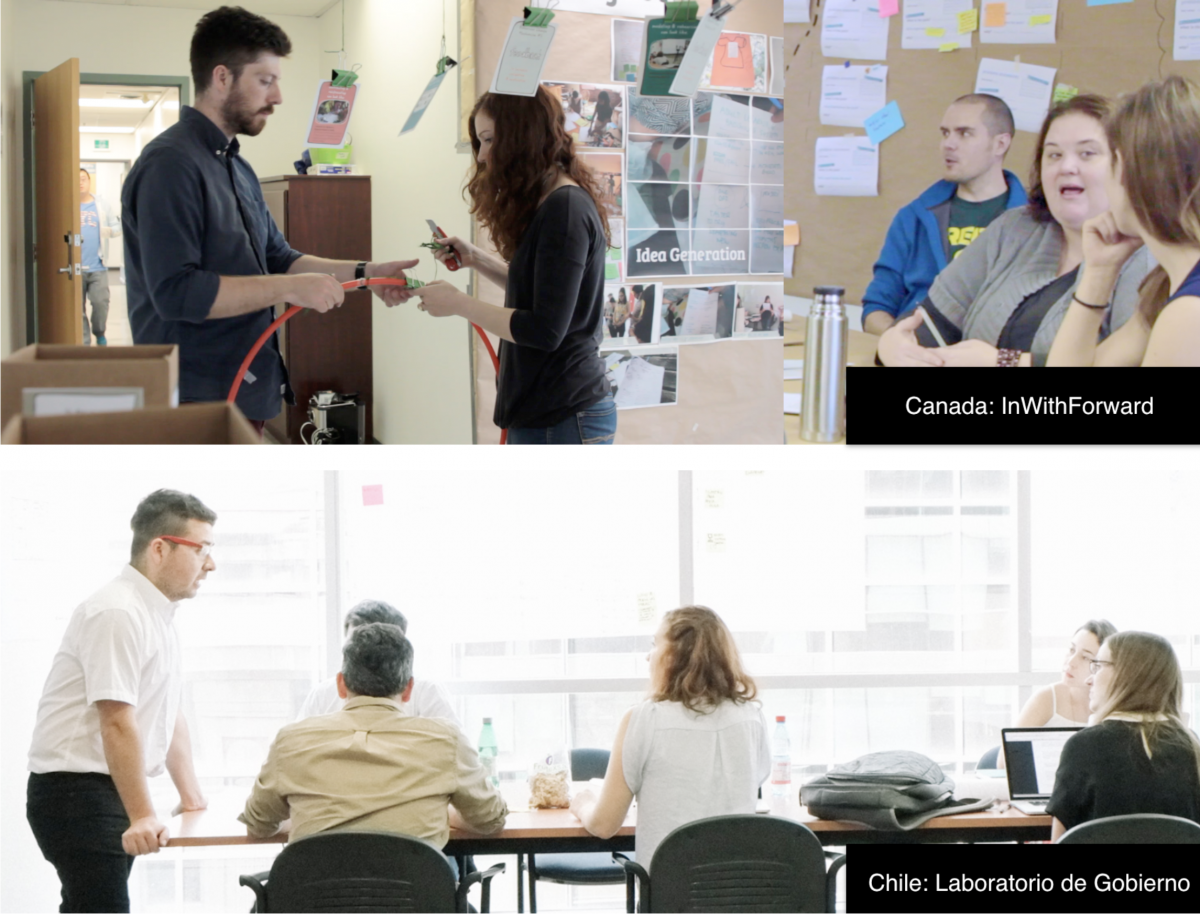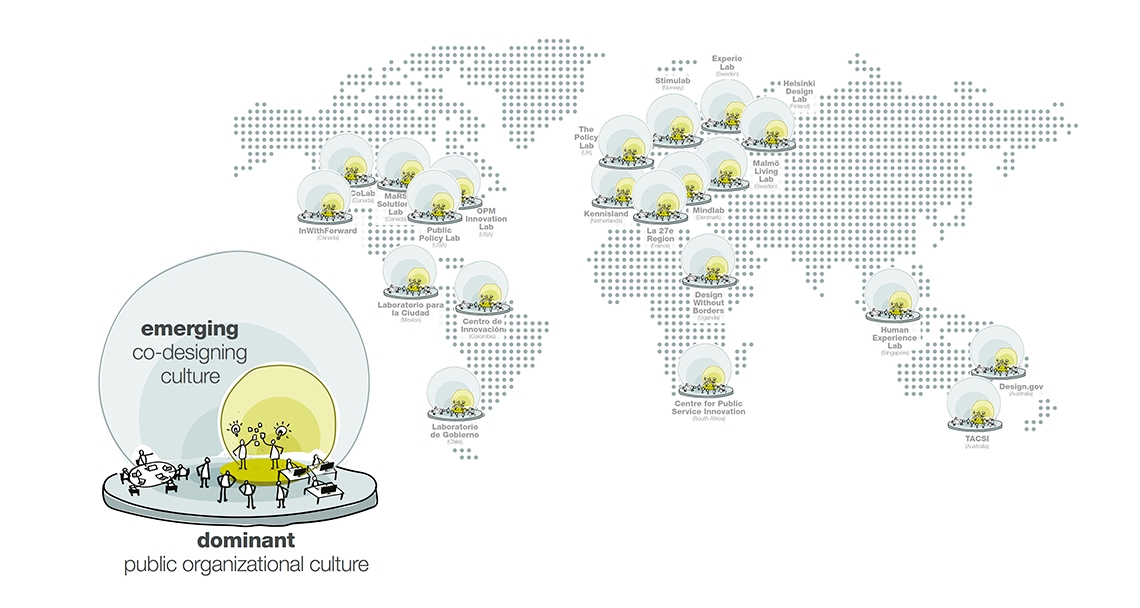The Ripppling Effect by Manuela Aguirre Ulloa
Manuela Aguirre Ulloa received her PhD degree at The Oslo School of Architecture and Design, June 5th 2020. Her thesis looks at how public organizations can build the capacity to co-design public services together with their users, not just for them. With that systemic service design mindset she hopes to bridge the disconnect between those who design and those who are served by public services, as all expertise, knowledge and design abilities are needed.
“I really want to find ways how we can redistribute power in society”, says Manuela. A Chilean designer who came to Norway ten years ago. Today she is an Associate Professor of Service Design, while also a design practitioner at Designit Oslo – a global design studio with presence in 16 cities worldwide.
“If we keep relying on systems and services being designed by people in power, we will always reinforce power inequalities”, says Manuela. “And one of our tickets to meaningful and active citizen participation is to build and disseminate competencies to participate in co-design”, Manuela explains.
“This way users, from patients, caregivers or students, may not only participate in democratic processes with their voice, but they can actively co-design and shape the services that affect their lives”, she explains. Her thesis has largely been inspired by the works of Béla Bánáthy, a Hungarian systemic designer who is fairly unknown in design.
“A lot of people have actually used his work without fully knowing where it came from, like the divergence-convergence dynamics of design, popularized by the UK’s Design Council in the 90s as the Double Diamond. Bánáthy basically says that it is not ethical to design for the other. And therefore, we can only design services and systems that affect us, and that challenges the very core of user-centred design”, Manuela explains.
“If we keep relying on systems and services being designed by people in power, we will always reinforce power inequalities”, says Manuela. “And one of our tickets to meaningful and active citizen participation is to build and disseminate competencies to participate in co-design”, Manuela explains.
“This way users, from patients, caregivers or students, may not only participate in democratic processes with their voice, but they can actively co-design and shape the services that affect their lives”, she explains. Her thesis has largely been inspired by the works of Béla Bánáthy, a Hungarian systemic designer who is fairly unknown in design.
“A lot of people have actually used his work without fully knowing where it came from, like the divergence-convergence dynamics of design, popularized by the UK’s Design Council in the 90s as the Double Diamond. Bánáthy basically says that it is not ethical to design for the other. And therefore, we can only design services and systems that affect us, and that challenges the very core of user-centred design”, Manuela explains.
A short simple question
For one of the case studies she participated in, she studied a public innovation program called Fifth Space where 30 social service workers from three of the largest agencies in the disability sector in British Colombia, Canada took part for half a year. “It has been 25 years since they moved from the segregated institutionalized model for caring and integration into communities for people with cognitive disabilities, and the services are still not good enough. We needed to do something different”, says Manuela.
One point the case study illustrated was how the system thinks it needs to gather information about users, without even questioning why we need it. “What if the information that we gather is not helping us to deliver something of value?” she asks. “Co-designing is not about consulting or gathering information about other people’s realities, it is about making intentional change together with all those who are affected by that change.“
One point the case study illustrated was how the system thinks it needs to gather information about users, without even questioning why we need it. “What if the information that we gather is not helping us to deliver something of value?” she asks. “Co-designing is not about consulting or gathering information about other people’s realities, it is about making intentional change together with all those who are affected by that change.“
«Ripppling» a cultural change
By contrasting experiences of building public sector innovation capacity in Fifth Space in Canada with a similar program called Experimenta in Chile, patterns surfaced in her research. “That’s when the concept of emerging and dominant organizational cultures became relevant. I could see that there was this tension between the current ways of doing things because it was challenged by the new ways that were introduced by the public innovation program”.

Manuela studied Fifth Space in Canada, program led by InWithForward together Burnabi Association for Community Inclusion, Kinsight and Posabilities (picture on the top) and Experimenta in Chile, led by Chile’s Government Innovation Lab (picture on the bottom).
In light of this mixed methods comparative study, Manuela started to develop the Ripppling model. The three Ps represents the physical, practical and paradigmatic dimension of nested cultural relationships. The model helps designers map out and acknowledge that we are embedded within cultural dynamics and interactions and that this affects how organizations respond to change.
“I chose ripples as a metaphor to represent organizational cultures. Hopefully, the emerging cultural change of co-designing can spread like a ripple and produce a rippling effect beyond the dominant organization and into society at large”.
Manuela believes co-designing can become an integral aspect of all social life. “Everybody can take part in co-designing the services and systems that affect their lives in a new form of co-liberating participatory democracy that values a plurality of Ripppling paradigms”.
The thesis “Transforming public organizations into co-designing culture. A study of capacity-building programs as learning ecosystems” is available here.

Manuela studied Fifth Space in Canada, program led by InWithForward together Burnabi Association for Community Inclusion, Kinsight and Posabilities (picture on the top) and Experimenta in Chile, led by Chile’s Government Innovation Lab (picture on the bottom).
In light of this mixed methods comparative study, Manuela started to develop the Ripppling model. The three Ps represents the physical, practical and paradigmatic dimension of nested cultural relationships. The model helps designers map out and acknowledge that we are embedded within cultural dynamics and interactions and that this affects how organizations respond to change.
“I chose ripples as a metaphor to represent organizational cultures. Hopefully, the emerging cultural change of co-designing can spread like a ripple and produce a rippling effect beyond the dominant organization and into society at large”.
Manuela believes co-designing can become an integral aspect of all social life. “Everybody can take part in co-designing the services and systems that affect their lives in a new form of co-liberating participatory democracy that values a plurality of Ripppling paradigms”.
The thesis “Transforming public organizations into co-designing culture. A study of capacity-building programs as learning ecosystems” is available here.
The thesis was conducted as part of AHO's Systems Oriented Design research group with the support of Professor Birger Sevaldson and Professor Andrew Morrison from AHO's Centre for Design Research. Manuela also thanks InWithForward and Chile's Laboratorio de Gobierno for their generous engagement and participation in this research project.
